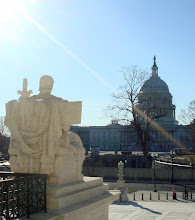Day 9: Court Packing
The wisdom of the Framers of the Constitution is evident not only in what they did write but in what they did not write. In other words, they were clear on the role and limitations of government; they also were deliberate in those issues they left open to the legislative process. The composition of the Supreme Court and inferior courts was one of those open issues.
Contemporaneous writers of the time, namely those writing the Federalist Papers and those writing what would become the Anti-Federalist Papers, also remained silent on this issue. Consequently, there is relatively little insight into the Framers’ thoughts on an ideal size for the court. Over time, the size of the Supreme Court has been increased and decreased.
The closest we get to such insight comes from the first Congress of the United State of America. Among those first congressional acts, was legislation to set the number of justices. The act was signed into law on the 24thof September 1789 by President George Washington. Section 1 of An ACT to establish the Judicial Courts of the United States set the number of justices at six – one chief justice and five associate judges.
With an even number, it was possible that ties would occur, which was a natural guard against overturning legislation (i.e., the will of the People) in close-call decisions. In the years and administrations that followed, the court would be expanded (as many as 10 in 1863) or contracted (as few as seven in 1866) to meet the political ends of parties in control of the government. The court has been a nine-member panel since 1869. In order to protect his New Deal programs from being declared unconstitutional, President Franklin Roosevelt proposed expanding the court to 15 justices as a shot across the bow in 1937. Consequently, the Supreme Court backed off of the New Deal programs, and the court remained a nine-justice panel.
Today, with what appears will be the appointment of Judge Coney-Barrett to the Supreme Court, the court’s balance will be tipped toward that of textualism, as opposed to positivism. This means the Constitution and our laws will be interpreted in the context of the times during which they were written. Wrong or right, this methodology seems to be associated with classical liberalism (e.g., conservatism) as opposed to progressivism. Because of the relative ages of the justices, it is likely that this balance would be preserved for many years.
Because many policies espoused by progressives are antithetical to the intent and spirit of the Constitution in that they tend to expand government’s involvement in citizens’ lives, a conservative court may be more likely to strike down legislation that inherently is government overreach. Take government-provided healthcare or education. Neither are constitutionally granted activities. This is not to say government cannot provide these things, it just means that they would rightly be provided at the state or local level, providing states or localities wanted to engage in these types of activities. Simply, these (and myriad other) activities are not legitimate functions of the federal government. This is what the Tenth Amendment is all about.
This is where court packing comes into play.
If one party controls the lawmaking and enforcement organs of government, namely the legislative and executive branches, but does not control the courts, there may be the temptation to expand the court and populate it with justices of similar political philosophies. To bring it in today’s context, if the Democrats win seats in Congress and win the Presidency, they will, as they have plainly stated, pursue an exceptionally progressive agenda. It is not inconceivable that their policies and programs could be challenged in court, and a conservative court could likely rule, applying a textualist lens, such policies and programs to be unconstitutional.
There is cause to believe, because they have so indicated, that Democrats would entertain expanding the court significantly in order to stack it with positivist judges, those likely to favor their progressive goals.
They would do well to be mindful of their “nuclear option” debacle, as discussed in Week 11. As political winds change, there is every reason to expect that Republicans would someday regain control and adjust the composition of the court to favor their ends.
This becomes a never-ending, vicious cycle that only serves to destabilize our republic. Considering this danger is important in the voting booth. While I doubt it is the single issue by which one’s vote is likely to be cast, it cannot be fully disregarded.

No comments:
Post a Comment